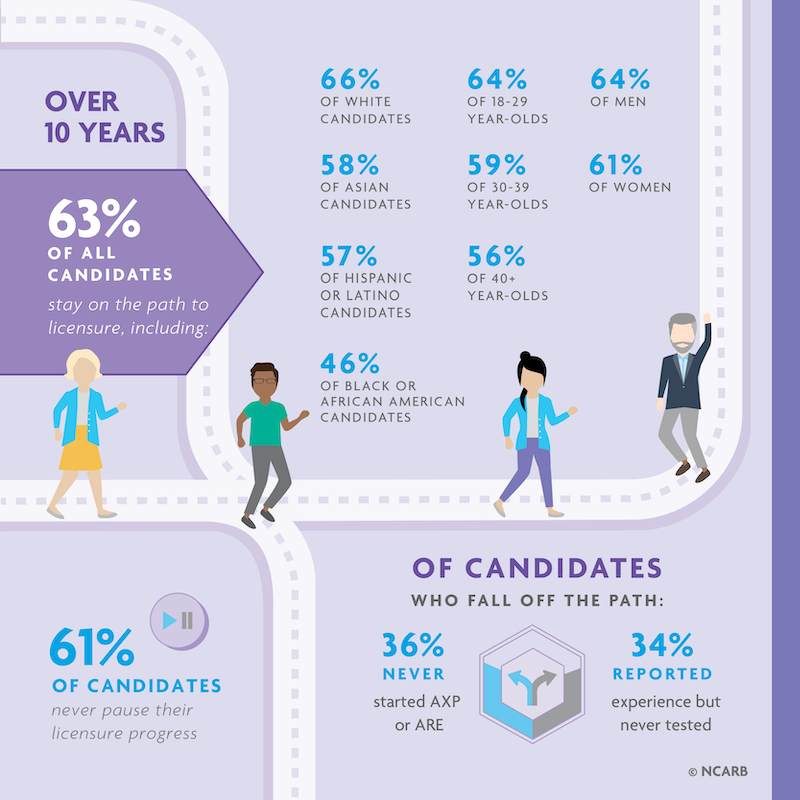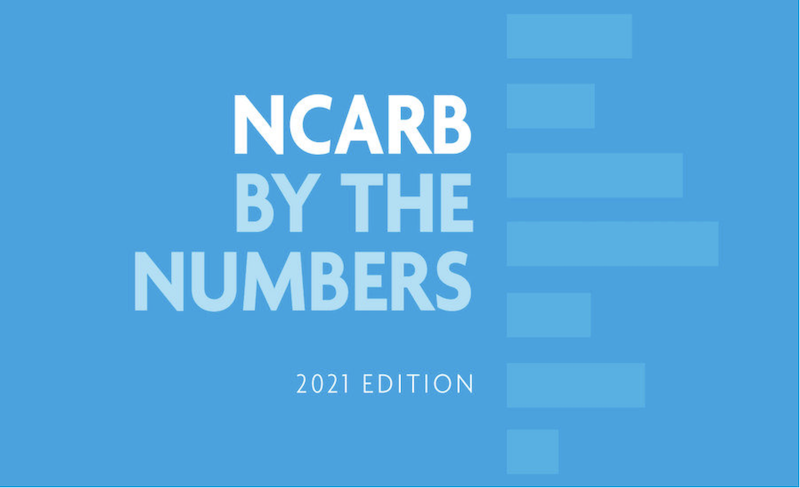On its 10th year of publishing information about its licensing exams, the National Council of Architectural Registration Boards (NCARB) for the first time has released a new section in the 2021 edition of its Architect Registration Examination that breaks down the pass rate by several demographic categories.
The six-part exam is required by all 55 NCARB jurisdictions in the U.S. for candidates seeking architectural licensure. More than 32,700 people took the test, and here are some of the key findings:
•White candidates’ pass rate is higher than that of candidates of color. The disparity is most pronounced in the Programming & Analysis division of the test that focuses on evaluating a project’s requirements and constraints; white candidates’ pass rate was 38 percentage points higher than their Black peers’.
•Men, in general, outperform women candidates on five of the exam’s six divisions. When factoring in race and ethnicity, Black women fare better on the test than Black male candidates.
•Candidates ages 18-29 have the highest pass rates across all six divisions. Candidates 40 years or older have the lowest rate.
Alfred Vidaurri Jr., FAIA, NCARB, AICP, who was inducted as NCARB’s president in June, stated that the findings were both unsurprising and unacceptable. “I challenge us to do better” he said of the industry, adding that he would concentrate on addressing these disparities during his tenure leading the organization.
The hardest part is getting some candidate groups to the finish line. NCARB reports that 63% of all candidates stay on their paths to licensure over 10 years, but that drops off to 61% for women candidates, 58% for Asian candidates, 57% for Hispanics, and 46% for Blacks.
NCARB WILL OFFER FREE PRACTICE TESTS

The report cites disparities in the rate of candidates pursuing licensure.
After commissioning an independent bias study of its exam, NCARB concluded that individual questions don’t drive disparities in candidates’ performance, and that the organization alone can’t resolve inequity in exam access and performance. “Coupled with NCARB’s data on career attrition, these studies suggest that pass rate disparities could also be impacted by access to education and professional experiences,” the organization stated.
Nevertheless, NCARB’s teams have been working to understand the causation of testing disparities, and the organization has pledged to launch the following changes, resources, and opportunities for feedback:
•For the first time in NCARB history, exam candidates have been appointed to the 2021 Examination Committee, which is responsible for recommending format and policy changes to NCARB’s national Board of Directors.
•NCARB is developing free practice tests for all six divisions, with a goal of offering the new suite of resources in mid-2022. (According to NCARB and the National Organization of Minority Architects’ joint Baseline on Belonging study, nearly half of respondents spent more than $500 on test prep materials.)
•NCARB is currently conducting another external audit of its exam, this time focused on the content areas to identify potential trends related to disparate pass rates.
•In addition to NCARB’s annual Think Tanks for emerging professionals and the upcoming Analysis of Practice study, the organization will launch two outreach initiatives in 2021-2022: licensure candidate focus groups conducted by an external consultant; and an Architecture Licensing Feedback survey, where the architect community can share their experience and recommendations.
•In 2019, NCARB launched an internal work group and commissioned external consultants to study licensure programs through an Equality, Diversity, and Inclusion lens. This effort is currently exploring potential links between exam performance and the criteria driving candidates’ Architectural Experience Program® (AXP®) reports, as well as firm culture.
The organization intends to release more details about these initiatives in the coming months.
Related Stories
K-12 Schools | Apr 30, 2024
Fully electric Oregon elementary school aims for net-zero carbon and resiliency
The River Grove Elementary School in Oregon was designed for net-zero carbon and resiliency to seismic events, storms, and wildfire. The roughly 82,000-sf school in a Portland suburb will feature a microgrid—a small-scale power grid that operates independently from the area’s electric grid.
AEC Tech | Apr 30, 2024
Lack of organizational readiness is biggest hurdle to artificial intelligence adoption
Managers of companies in the industrial sector, including construction, have bought the hype of artificial intelligence (AI) as a transformative technology, but their organizations are not ready to realize its promise, according to research from IFS, a global cloud enterprise software company. An IFS survey of 1,700 senior decision-makers found that 84% of executives anticipate massive organizational benefits from AI.
Codes and Standards | Apr 30, 2024
Updated document details methods of testing fenestration for exterior walls
The Fenestration and Glazing Industry Alliance (FGIA) updated a document serving a recommended practice for determining test methodology for laboratory and field testing of exterior wall systems. The document pertains to products covered by an AAMA standard such as curtain walls, storefronts, window walls, and sloped glazing. AAMA 501-24, Methods of Test for Exterior Walls was last updated in 2015.
MFPRO+ News | Apr 29, 2024
World’s largest 3D printer could create entire neighborhoods
The University of Maine recently unveiled the world’s largest 3D printer said to be able to create entire neighborhoods. The machine is four times larger than a preceding model that was first tested in 2019. The older model was used to create a 600 sf single-family home made of recyclable wood fiber and bio-resin materials.
K-12 Schools | Apr 29, 2024
Tomorrow's classrooms: Designing schools for the digital age
In a world where technology’s rapid pace has reshaped how we live, work, and communicate, it should be no surprise that it’s also changing the PreK-12 education landscape.
Adaptive Reuse | Apr 29, 2024
6 characteristics of a successful adaptive reuse conversion
In the continuous battle against housing shortages and the surplus of vacant buildings, developers are turning their attention to the viability of adaptive reuse for their properties.
AEC Innovators | Apr 26, 2024
National Institute of Building Sciences announces Building Innovation 2024 schedule
The National Institute of Building Sciences is hosting its annual Building Innovation conference, May 22-24 at the Capital Hilton in Washington, D.C. BI2024 brings together everyone who impacts the built environment: government agencies, contractors, the private sector, architects, scientists, and more.
Mass Timber | Apr 25, 2024
Bjarke Ingels Group designs a mass timber cube structure for the University of Kansas
Bjarke Ingels Group (BIG) and executive architect BNIM have unveiled their design for a new mass timber cube structure called the Makers’ KUbe for the University of Kansas School of Architecture & Design. A six-story, 50,000-sf building for learning and collaboration, the light-filled KUbe will house studio and teaching space, 3D-printing and robotic labs, and a ground-level cafe, all organized around a central core.
Sports and Recreational Facilities | Apr 25, 2024
How pools can positively affect communities
Clark Nexsen senior architects Jennifer Heintz and Dorothea Schulz discuss how pools can create jobs, break down barriers, and create opportunities within communities.
Senior Living Design | Apr 24, 2024
Nation's largest Passive House senior living facility completed in Portland, Ore.
Construction of Parkview, a high-rise expansion of a Continuing Care Retirement Community (CCRC) in Portland, Ore., completed recently. The senior living facility is touted as the largest Passive House structure on the West Coast, and the largest Passive House senior living building in the country.

















